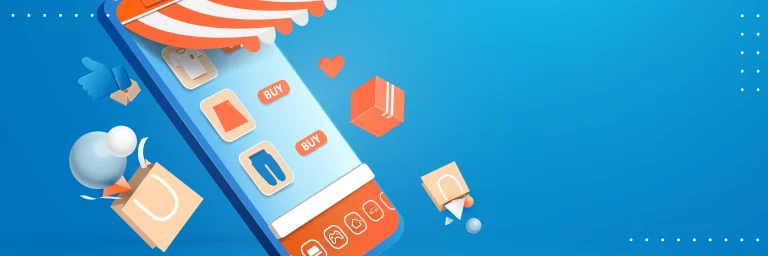How to Build a SaaS App in 2024

From Google Docs to Trello, we use Software as a Service that offers undeniable business benefits. Not a new, but still actively developing form of services distribution has become a new evolutionary stage after physical distribution, attracting developers and startups worldwide with its value
In this article, we will consider the SaaS phenomenon, tell you why it is more relevant than ever in 2022, highlight the main challenges, as well as give answers on how to build a SaaS app and how much it will cost.
What is a SaaS platform?
SaaS is a new model for the digital services distribution in which the web application is hosted by the provider remotely in a cloud form. Thanks to the cloud-based SaaS format, the user gets rid of the need to install, configure, and maintain software, simply renting the desired app for a certain period. As a result, all administrative tasks are performed by a service provider while the customer only needs an active Internet connection.
One more advantage of SaaS on the way to capturing the world is accessibility from different devices anywhere with continuous synchronization — something that local software lacks. Thereby, SaaS provides convenience for users’ work processes and cost-saving when expanding your business: you will only need to choose a suitable pricing plan instead of purchasing new hardware.
The difference from the traditional paid applications is that the SaaS license is temporary and distributed according to a subscription model. Developers are constantly working on this product, updating it and adding new features even after the release, so it is upgraded automatically without the need for users to buy new versions.
Why you should develop a SaaS product in 2024
If you wonder whether you should create a SaaS application in 2022 or not, you need to know that experts predict the SaaS market will grow to $716 billion by 2028, thanks to which SaaS will take up almost half of the global digital business. Driven by the growth of cloud software, more than 80% of applications will be SaaS in 2022.
SaaS platforms are one of the simplest ways to develop software projects, providing ready-made tools for building diverse business solutions, such as e-commerce sites, CRM, ERP, project management software, and much more. SaaS apps are delivered in electronic form: usually, it is a license key, a distribution of the software code, and access to a free support center. Thus, the customer receives all the necessary tools for their business.
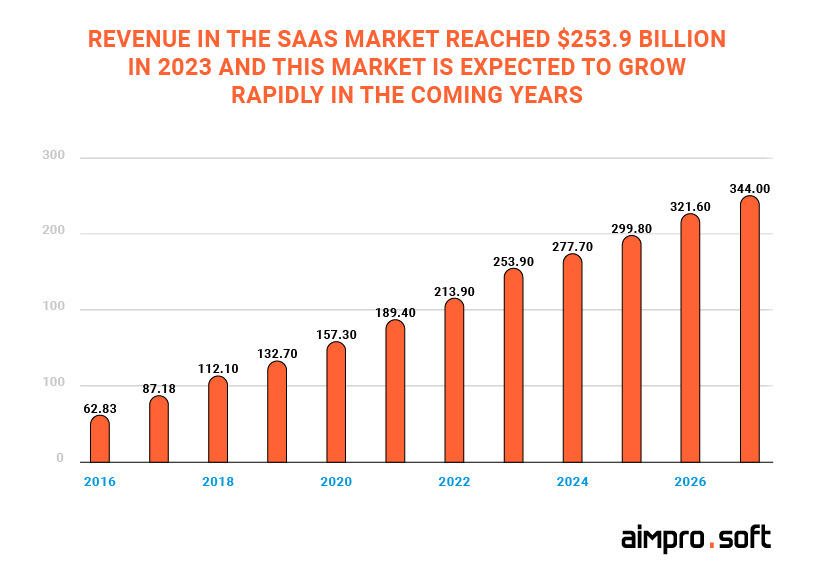
Building a SaaS platform offers such advantages:
- Large customer base
Factors like free trial periods, the reduced cost compared to traditional software, and the ability to use multiple devices under one account influence the formation of a stable client base.
- Source of regular income
SaaS solution that fully covers the users’ needs and allows building an established customer base will bring you a steady income.
- Security of your code
Customers do not have access to the source code, which eliminates the risk of illegal theft of the SaaS product’s code parts.
Now that you’ve seen the bright side of the coin, it’s time to take a look at the complexities that await you when working with SaaS software and learn how to avoid them.
Challenges of SaaS application development
The unique advantages of SaaS platforms coexist with specific challenges. All of them are connected with SaaS software features and arise during the development process.
1. Continuous availability
System availability is one of the fundamental requirements of SaaS solutions. When new system versions are released, customers’ access to the application may be limited, which leads to productivity lag and, as a result, in financial losses for businesses. To prevent this, developers should use a zero-time deployment strategy. It lies in maintaining full system responsiveness during deployment, which allows you to avoid downtime completely.
2. Compliant database access
As a SaaS provider, it is your responsibility to ensure the security and confidentiality of customer data. To do this, you need to develop a robust database design that will comply with the main regulations. The GDPR (General Data Protection Regulation) requirements for European Union and HIPAA (Health Insurance Portability and Accountability Act) requirements for the USA should be determined at the initial stages of the project. Integration and unit tests should be applied throughout development to ensure that limited access to information is applied.
Learn more about GDPR compliance from our special guide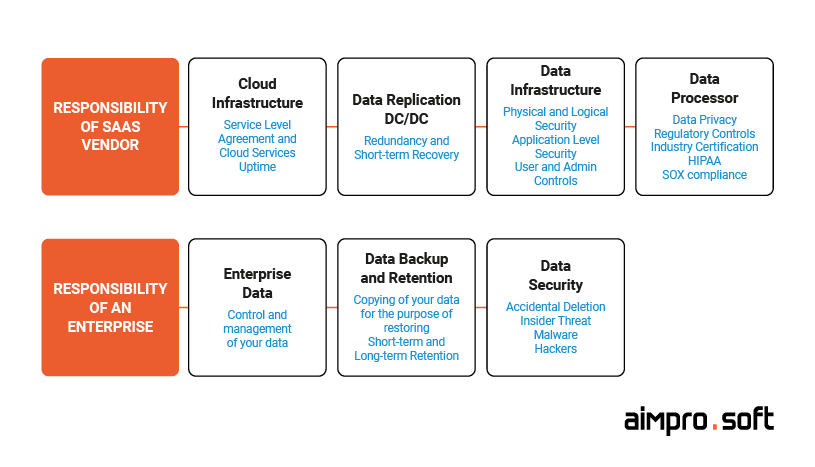
3. Third-party payment integration
In SaaS applications, the payment feature is mainly accomplished by the system integration with third-party payment services. When choosing a suitable service, you can focus on those that offer advanced integration support: Paypal, BrainTree, QuickPay provide libraries for successful integration. Alternatively, your developers can study the technical features of the smooth external payment integration and ensure its correct operation by creating the appropriate application parts like facades and services for seamless integration. In this case, be ready to spend more time and money on the quality result.
Read more about how to integrate a payment gateway in Hybris4. SaaS subscription lifecycle
The specificity of SaaS products lies in close interaction with billing plans and subscriptions. This can be achieved in two ways: using a ready-made solution or creating your own subscription management solution.
In the first case, such products as Stripe can be easily integrated with the payment service since they provide their API and detailed documentation for SaaS systems. This method is convenient and easy, but you will depend on the provider and pay monthly to use their solution.
Building your own subscription and plan management solution saves you from these shortcomings but requires careful creation of the entire SaaS life cycle management aspect: subscription, tracking, updating, re-subscription, and cancellation. Needless to say, this will entail additional costs and time.
5. Customizable system
A good system inevitably has to be customized at all levels, from the interface to subdomains. Setting up each element separately for different clients is not an easy task for a developer and not cheap for a customer, but the competent implementation of customization will bring significant benefits to the company in the long term perspective.
So, knowing what difficulties you may expect during SaaS development, let’s look at its product creation technical steps.
5 steps to build a SaaS product
The great competitiveness of the SaaS market and the specifics of SaaS product creation requires several steps to be followed for its successful implementation. In this regard, it seems essential to start a SaaS product from the very beginning and move from idea development and market evaluation to the technical implementation of your concepts step by step. So let’s start from the very beginning.
1. Business idea validation
In order to build a SaaS platform, you should start with the definition of your business idea through precise market research. When studying the market, it is important to identify your target audience, their needs and possible solutions your product offers. We also advise you to focus on competitors’ SaaS apps since analyzing their monetization models and features will give you valuable data for identifying where you can stand out with your product.
So, when validating a business idea, you should conduct the following stages:
- determine the feasibility of your idea using market research
- identify the target audience and their needs;
- decide on a monetization strategy for your SaaS application;
- consider the necessity of implementing cloud services in your project;
- handle the feedback and make the final decision.
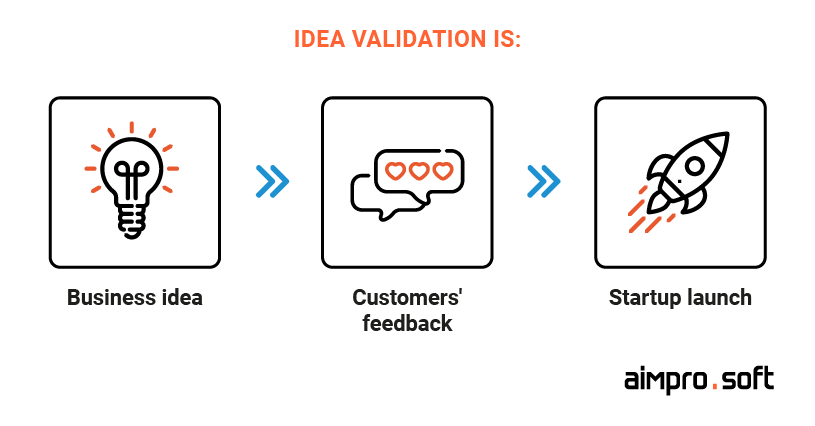
2. Choose tech stack
Having identified the value of your idea and carried out market research, it’s time to look at how to make a SaaS application. The choice of tech stack for a SaaS depends on your requirements and many independent factors such as your software ecosystem environment or your developers’ team experience. It is also necessary to consider the performance rate, ease of deployment, and search for specialists in the market.
So, if the project is not complex and does not require high performance or is connected with IoT, then using Python would be a good option. If the project is enterprise-level with many integrations and features, then it is better to use Java. In addition, if your entire ecosystem is written in Node.js, then you should also use Node.js to build a SaaS website. Thus, you’ll simplify the front-end and back-end development as it will be written in the same environment.
We have provided the most obvious examples, but under certain conditions, SaaS solutions can and should be written in another language depending on various reasons, such as your software ecosystem and the deployment location.
3. Define the list of features
As for the functionality, we can distinguish such must-have features without which a SaaS platform won’t bring value to its users:
- Availability — the ability to log in at any time from anywhere. To achieve it, we advise:
- removing any single point of failure, such as routers, servers, and power sources;
- prepare your infrastructure for zone failure by spreading your applications’ servers across two or more zones and replicating data across them;
- implement automatic failover to support continuous availability in the cloud.
- Scalability — the ability of the system to cope with the increase in workload. Be aware of the importance of artificially limiting your servers so that clients use their capacity equally. Otherwise, it will lead to overload and reputation losses.
- Security — the safety of authentication, authorization, access control, and data protection for sharing by different tenants.
- Easy customization — each SaaS user must have an admin panel to configure various options and pay for services.
- Expandability — the ability to add to the existing system new features, events, and objects repeatedly. If the basic functionality is implemented at the initial stage of the platform development, then enable that later architecture can be expanded with new blocks, while the foundation remains unchanged.
- Documentation — such documentation as tutorials, guides, references, manuals, and product docs should be simple, brief but comprehensive, and contextual as it directly influences forming strong relationships with your customers.
4. Development particularities
It is necessary to note two essential things before you create a SaaS website. Firstly, hot deployment should be a higher priority in SaaS projects so that nothing falls off when uploading to production on the client-side.
Secondly, you need to maintain old versions of the API requests for at least a year after changing and informing customers in the mailing list about switching to the new API. Please note that this requirement is only relevant if the SaaS supports the API, which is not always the case. You need to pay special attention to these two points when developing and deploying a SaaS product to maintain a high service level.
Furthermore, another crucial thing to consider when building a SaaS platform is choosing a business model and monetization strategy. But this issue is really major, so we will talk it over separately in the next section.
Monetization strategy
Subscription is the most used monetization model for SaaS products. However, there are several variations of this strategy that you may apply depending on the product characteristics. Now let’s evaluate each of them.
| Monetization model | Definition | Strength | Weakness | Examples |
|---|---|---|---|---|
| Flat rate pricing | The classic model where a direct payment is made for full access to the product for a certain period of time (month, year, etc.). | A clear selling point, which is rather predictable and easy to understand for the customer. | Income comes exclusively from subscribers, not ads, which may be insufficient if you have a small user base. Moreover, the over-abundant feature package may seem unnecessary for some users who need a moderate number of specific features. | Buffer, CartHook |
| User-based pricing | In this model, each new user in the application requires an additional fee, which is especially beneficial when selling services to large enterprises. | Income tends to increase passively. The customer gets access to a full-feature product, which reduces the chance of user churn. | Income is often difficult to predict and it depends entirely on the number of users. | Canva |
| Usage-based pricing | The customers get as much as they pay. The price is determined based on the number of API request frequencies, the amount of data used, etc. | High demand is achieved thanks to a clear and flexible pricing system. | Difficulty in predicting revenue rates, as payments can constantly float, which affects business stability. | Amazon Web Services, Salesforce |
| Feature-based pricing | The price of this monetization model is based on feature sets. Usually, there are several of them: Standart, Premium, Pro, etc | Thanks to the functionality distributed over the sets, coverage of different target audiences is achieved. | To create a sufficient number of feature sets, you need to develop rich functionality, which requires significant investment of money and time. | PandaDoc, Leadpages |
| Freemium | The free version of some apps contains limited functionality that can be unlocked by purchasing the full version | Easily and effectively attracts new users and clients | It is often difficult to strike a balance between free and paid functionality | Dropbox, Spotify, Trello, Slack |
Now that we have seen the full picture of building SaaS applications, it’s time to find out how much it will cost.
How Much Does It Cost to Create a SaaS Platform
Please note that we provide only the lower bounds of the MVP price. This is due to the specificity of SaaS, which is very changeable from project to project and depends on the customer’s requirements, goals, and vendor’s capabilities. To get a precise price of a potential SaaS product, you should contact the software vendor that will make an estimation.
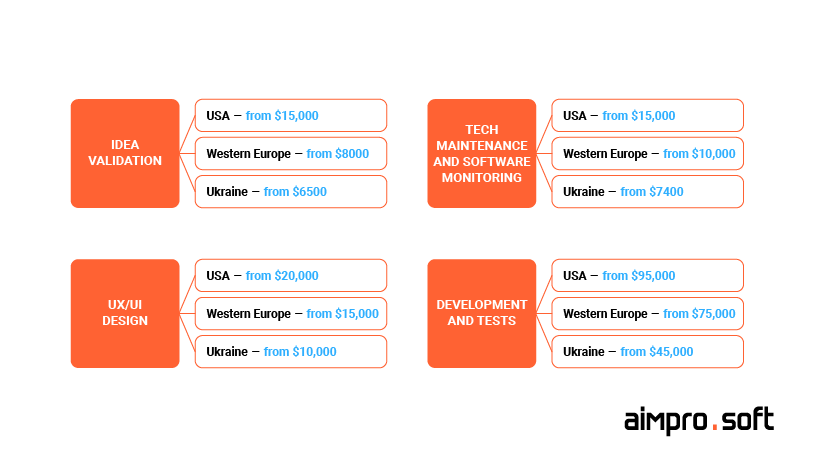
Be aware of how the price varies from country to country. In the USA and Western Europe, software services are the most expensive at $80 and $65 per hour, so the price will go up respectively. There is no difference in developers’ qualification level in Eastern European countries like Ukraine, but the price of $30 per hour is half of the Western companies’ one.
Conclusion
Approaches to digital services distribution have changed over the years, and the SaaS is now mainstream. Therefore, if you have an idea of SaaS web development but lack a modern form for its implementation, contact us, and we will help clothe your idea in a modern SaaS shell, both informational support and practical contribution.
Frequently Asked Questions
How to develop a SaaS product?
The process of SaaS platform development is complicated and includes a few stages, starting from business idea validation to the creation stage. To build a Software as a Service platform architecture, define the appropriate tech stack, and incorporate all the development particularities, you need an experienced development team. If your own team does not have the necessary skills, we advise you to find a reliable software vendor that will do it for you.
Why should you create a custom SaaS product?
According to preliminary forecasts, the next decade will see a complete transformation of digital services into cloud form. SaaS products make the most of the cloud concept, so companies that are the first to adopt this technology in their business will come to the forefront of this market.
How challenging is it to develop a SaaS application?
In order to make a SaaS product, your team should have a certain set of skills, first of all, knowledge of cloud development specifics since it is the core of such software. Cloud development includes the planning and development of cloud architecture, as well as the implementation and management of cloud delivery models. If you don’t have relevant expertise in this field, we advise you to gain assistance from an experienced SaaS software development team with a proven portfolio of completed cases.
Is it possible to write SaaS in one specific language?
If desired, SaaS can be written in any language, depending on the customer’s requirements.
Is it true that SaaS needs to be deployed only on the cloud platform?
SaaS can be deployed both on cloud platforms like Azure, Amazon Web Services, or Google Cloud, as well as on customers’ own servers. In the second case, it will still be perceived as a cloud for the client but would require more expense for support and maintenance.


